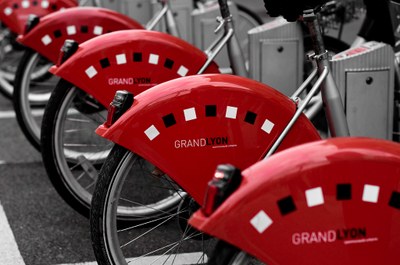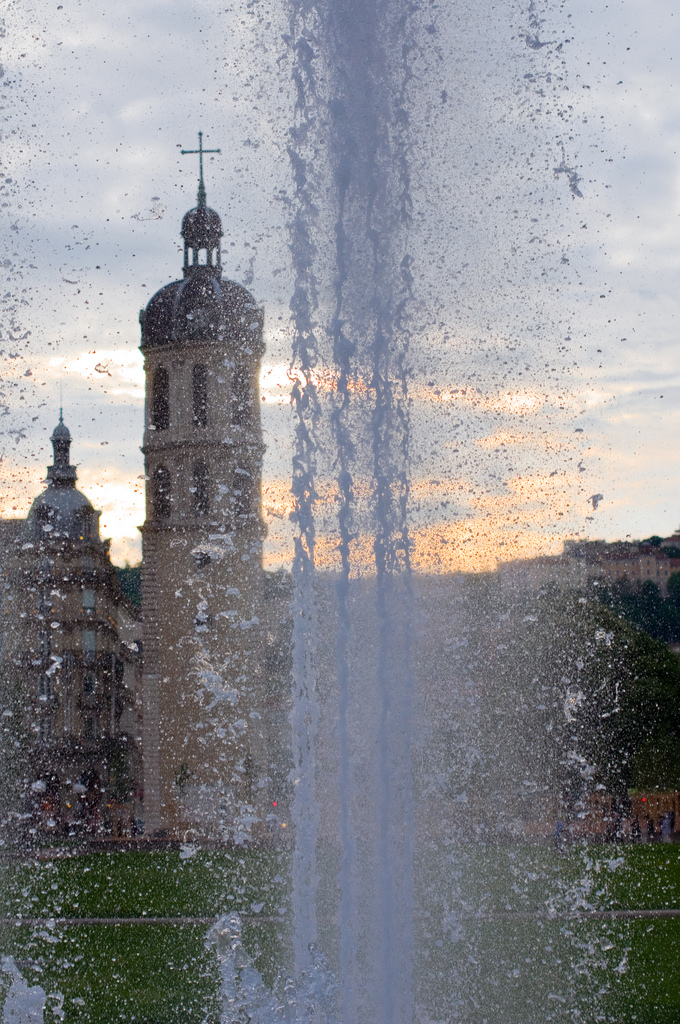The city of Lyon
The city is known for its historical and architectural landmarks and is a UNESCO World Heritage Site. Lyon was historically known as an important area for the production and weaving of silk and in modern times has developed a reputation as the capital of gastronomy in France. It has a significant role in the history of cinema due to Auguste and Louis Lumière who invented the cinematographer in Lyon. The city is also known for its famous light festival 'Fete des Lumières' which occurs every 8 December and lasts for four days, that valued Lyon the title of Capital of Lights (not to be mixed up with Paris the city of lights).
Founded  by the Romans, with many preserved historical areas, Lyon is the archetype of the heritage city, as recognised by UNESCO.
by the Romans, with many preserved historical areas, Lyon is the archetype of the heritage city, as recognised by UNESCO.
Lyon is now a vibrant metropolis which starts to make the most out of its unique architectural, cultural and gastronomic heritage, its dynamic demographics and economy and its strategic location between Northern and Southern Europe. It is more and more open to the world, with an increasing number of students and international events.
History
All periods of Lyon's 2000-year history have left visible traces in the city's architectural and cultural heritage, from Roman ruins to Renaissance palaces to contemporary skyscrapers. It never went through a major disaster (earthquake, fire, extensive bombing...) or a complete redesign by urban planners. Very few cities in the world boast such diversity in their urban structure and architecture.
Early traces of settlement date back to 12,000 BC but there is no evidence of continuous occupation prior to the Roman era.
Lugdunum, the Roman name of the city, was officially founded in 43 BC by Lucius Munatius Plancus, then Governor of Gaul. The first Roman settlements were on Fourvière hill. The main period of peace and prosperity of the Roman city was between 69 and 192 AD. The population at that time is estimated between 50,000 and 80,000.

In the Middle Ages, the city developed on both banks of the Saone. The name "Lion" or "Lyon" appeared in the 13th century.
In the Renaissance, fiscal advantages and the organisation of numerous trade fairs attracted bankers from Florence and merchants from all over Europe; the city became more and more prosperous and experienced a second golden age. The main industries were silk weaving, introduced in 1536, and printing. Lyon became one of Europe's largest cities and its first financial place.
In the following centuries, Lyon was hurt by the religious wars but remained a major industrial and intellectual centre, while the financial activity moved to Geneva and Switzerland. In the 18th century, half of the inhabitants were silk workers (canuts).
In the early 19th century, the silk industry was still developing, notably thanks to Jacquard's loom which made the weaving work more efficient. Social crises, however, occurred: in 1831, the first revolt of the canuts was harshly repressed. The workers were protesting against the introduction of new technology, which was likely to cause unemployment. Other riots took place in 1834, 1848 and 1849, especially in the Croix-Rousse neighbourhood.
The traditional silk industry disappeared at the end of the century because of diseases affecting the French silk worms and the opening of the Suez Canal which reduced the price of imported silk from Asia.
Various other industries developed at that time; the most famous entrepreneurs of the late 19th century were the Lumière brothers, who invented cinema in Lyon in 1895.
The world's firs t funicular railway was built between Lyon and La Croix-Rousse in 1862.
t funicular railway was built between Lyon and La Croix-Rousse in 1862.
During World War II, Lyon was close to the border between the "free zone" and the occupied zone and was therefore a key strategic place for the Germans and the French Resistance alike. The traboules, or secret passages, through the houses enabled the local people to escape Gestapo raids. On 26 May 1944, Lyon was bombed by the Allied aviation. The Liberation of Lyon occurred on 3 September.
In the 1960s, the construction of the business district of Part-Dieu began; its symbol is the "pencil" tower, the tallest building in Lyon.
Geography
Lyon is a city in east-central France in the Rhône-Alpes region, situated between Paris and Marseille. Lyon is located at 470 km (292 mi) from Paris. The residents of the city are called Lyonnais.
The city of Lyon has 480,660 inhabitants. Together with its suburbs and satellite towns, Lyon forms the largest agglomeration (urban area) in France outside Paris with a population estimated to be 1,422,331.
Lyon's geography is dominated by the Rhône and Saone rivers that converge to the south of the historic city centre forming a peninsula or "Presqu'île"; two large hills, one to the west and one to the north of the historic city centre; and a large plain which sprawls eastward from the historic city centre. The original medieval city (Vieux Lyon) was built on the west bank of the Saone river at the foot of the Fourvière hill, west of the Presqu'île. This area, along with portions of the Presqu'île and much of the Croix-Rousse is recognized as a UNESCO World Heritage Site.
To the west is Fourvière, known as "the hill that prays", the location for the highly decorated basilica of Notre-Dame de Fourvière, several convents, the palace of the Archbishop, the Metallic Tower (a highly visible TV tower, replicating the last stage of the Eiffel Tower) and a funicular (a railway on a steep hill).
 To the north is the Croix-Rousse, "the hill that works", traditionally home to many small silk workshops, an industry for which the city was once renowned.
To the north is the Croix-Rousse, "the hill that works", traditionally home to many small silk workshops, an industry for which the city was once renowned.
East of the Rhône from the Presqu'île is a large area of flat ground upon which sits much of modern Lyon and most of the city's population.
North of this district is the relatively wealthy 6th arrondissement, which is home to the Parc de la Tête d'Or, one of Europe's largest urban parks, and Interpol's world headquarters on the park's western edge.
UNESCO World Heritage Site
The Historic Site of Lyon was designated a UNESCO World Heritage Site in 1998. In their designation, UNESCO cited the “exceptional testimony to the continuity of urban settlement over more than two millennia on a site of great commercial and strategic significance”. The specific regions composing the Historic Site include the Roman district and Fourvière, the Renaissance district (Old Lyon), the silk district (slopes of Croix-Rousse), and the Presqu'île, which features architecture from the 12th century to modern times. Both Old Lyon and the slopes of Croix-Rousse are known for their narrow passageways (named traboules) that pass through buildings and link streets on either side. The first examples of traboules are thought to have been built in Lyon in the 4th century.
Seeing
Lyon may not have world-famous monuments such as the Eiffel tower or the Statue of Liberty, but it offers very diverse neighbourhoods which are interesting to walk around and hide architectural marvels. As time goes by, the city also becomes more and more welcoming for pedestrians and cyclists. So a good way to explore it may be to get lost somewhere and enjoy what comes up, and not to always follow the guide...
Vieux Lyon (Old Lyon)
After Venice, the Old Lyon, a narrow strip along the right bank of the Saône, is the largest Renaissance area in Europe. Its current organization, with narrow streets mainly parallel to the river, dates back to the middle Ages.
The traboules are a typical architectural feature of Lyon's historical buildings. They are corridors which link two streets through a building, and usually a courtyard. Many traboules are unique architectural masterpieces, largely influenced by Italy and especially Florence.
Fourvière, Saint-Just
 Fourvière was the original location of the Roman Lugdunum.
Fourvière was the original location of the Roman Lugdunum.
• Panoramic viewpoint, place de Fourvière
Next to the basilica is the panoramic viewpoint, with the best view over the city. If the weather is clear, Mont Blanc can be seen in the distance.
• Metal tower
Next to the basilica stands a smaller (86 m, 282 ft) replica of the Eiffel Tower, completed in 1894.
• Roman theatres
These two well-preserved theatres are the most important remnant of the Roman city of Lugdunum. The Gallo-Roman museum was built next to them. The summer festival "Nuits de Fourvière" takes place here every year.
Croix-Rousse
Croix-Rousse is known as the "working hill", the main silk production area. On the slopes was the Roman Federal Sanctuary of the Three Gauls, which comprised the amphitheatre (built in 19) and an altar (built in 12 BC).
The neighbourhood is still one of the most densely populated in Europe.
• Amphitheatre des Trois Gaules
Documents say that it was the largest theatre in Gaul at that time, but nobody knows exactly how far it extends under the neighbouring buildings, nor what remains from the Roman era after centuries of construction.
Museums and Galleries
• Museum of Fine Arts
• Museum of Contemporary Art
• Lumière Institute - Living museum of cinema. Located in the Lumière brothers' house, this museum presents an interesting history of cinema through various items and film excerpts and other early cinematic and photographic artefacts. Also worth seeing for the lovely architecture.
• Gallo-roman museum of Fourvière. The second largest museum in France, it has all kinds of things relating to Rhone-Alps history.
• Miniature and Movie scenery Museum. Created by artist Dan Ohlmann, this private gallery shows about 120 miniature models of all kinds of scenes: houses, restaurants, workshops, schools, etc., from Lyon or elsewhere, historical or contemporary.
Parks and Gardens
• Park of la Tête d'Or : Completed in 1862, this 105-hectare English-style garden is one of the largest and arguably one of the most beautiful urban parks in France. The highlights of the park include the large greenhouses, the botanical garden, the rose garden and the "African plain" in which animals wander in a natural-style environment.
• The right bank of the river Rhône has recently been turned into a 5-km promenade with various landscapes and great views over the Croix-Rousse and Presqu'Ile areas.
Gastronomy
For several centuries Lyon has been known as the French capital of gastronomy, due in part to the presence of many of France's finest chefs in the city and its surroundings. This reputation also comes from the fact that two of France's best known wine-growing regions are located near Lyon: the Beaujolais to the North, and the Côtes du Rhône to the South.
Lyon is the home of very typical and traditional restaurants serving local dishes, and local wines: the bouchons.
Other
• Lyon was an early centre for printing books, and nurtured a circle of 16th century poets.
• Lyon is also the French capital of "trompe l'œil" walls, a very ancient tradition. Many are to be seen around the city.
• The unusual project Lyon Dubai City, a reproduction of some districts of Lyon in Dubai, is a major point for the tourism in Lyon.
• Lyon is a pilot city of the Council of Europe and the European Commission Intercultural cities programme.

